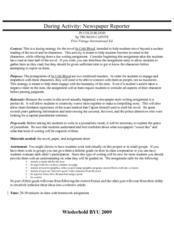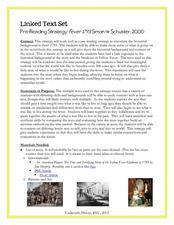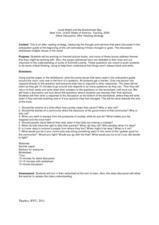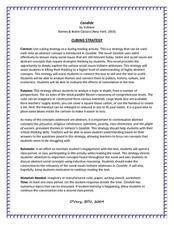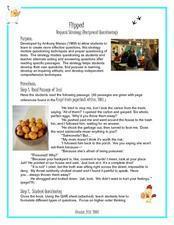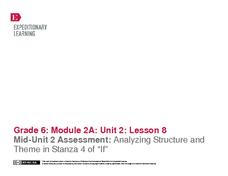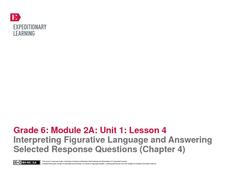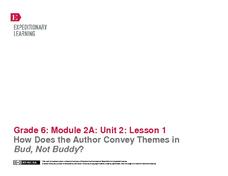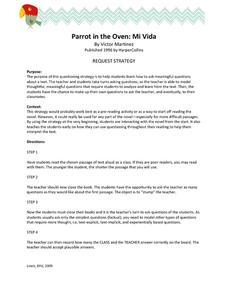Curated OER
Hatchet: Predicting the Outcome Guide
What will happen in Hatchet by Gary Paulsen? Kids read a series of possible events that will occur in the novel and mark whether they agree or disagree with the probability of each event happening.
Curated OER
Peter and the Starcatchers: K-W-H-L Strategy
Bookend your study of Peter and the Starcatchers with a KWHL centered around treasure and power. Pupils work in small groups to compile knowledge and questions and then revisit this chart after reading and research.
Curated OER
Pre-Reading Strategy Instructional Routine: Maus I and II
Vladek's attitudes are difficult for many young learners to understand. Prepare your class for the events represented in Art Speigelman's graphic novel with a pre-reading activity that has them read articles about and interviews with...
Curated OER
Maus: After Reading Strategy Instructional Routine
Class members create literary mandalas for two characters from Maus, Art Spiegelman’s graphic novel about his father’s experiences with the Holocaust. After finding quotes that reveal three good traits and three bad traits of each...
Novelinks
Count of Monte Cristo: Questioning Strategy – Tossed Terms
Do you know the setting of The Count of Monte Cristo? What about the main characters? Explore the elements of Alexandre Dumas' novel with a reading comprehension activity. Kids toss boxes with literary elements written on each side,...
Curated OER
In Cold Blood: A During Reading Activity
Following the method used by Truman Capote, class members research a major character from his novel, In Cold Blood, and then conduct an interview with that character. The resulting research is used to craft a newspaper article about the...
Curated OER
Linked Text Set: Pre-Reading Strategy. Fever 1793
The historical background for Fever 1793 is the focus of a pre-reading strategy that has class groups rotate through a series of stations stocked with photographs, articles, and other texts that describe the Yellow Fever outbreak of...
Curated OER
Before, During, and After Strategies For The Catcher in the Rye Chapters 21-23
Create a personal website for Phoebe. Play a song dealing with non-conformity. Have class members write an advice letter to Holden. Here's a teacher resource meant to accompany The Catcher in the Rye that is chock-full of strategies. It...
Curated OER
Hiroshima: Question Answer Response Strategy (QAR)
“The crux of the matter is whether total war in its present form is justifiable. . .” After reading “The Aftermath,” the final chapter of Hiroshima, class members use a Question Answer Response (QAR) strategy to reflect on issues raised...
Brigham Young University
Silent Discussion: After Reading Strategy for Lizzie Bright and the Buckminster Boy
Complete this after-reading activity for the novel Lizzie Bright and the Buckminster Boy in order to explore the books themes of societal prejudice, peer pressure, authority, and bullying. Write the seven provided questions on...
Novelinks
Treasure Island: Anticipation Guide
Captain Long John Silver himself would consider this anticipation guide a treasure. Full of rereading predictions for readers to consider, the anticipation guide makes the class excited to begin reading Robert Lois Stevenson's Treasure...
Curated OER
Candide Cubing Strategy
Candide is a dense text. To assist in analyzing Voltaire's satire, groups employ a cubing strategy based on Bloom's taxonomy. Complete directions for the strategy, a template for the cube, a worksheet, and a topic list are included.
Curated OER
Mississippi Trial, 1955: A Request Strategy for Questioning
Knowledge, comprehension, application, analysis, synthesis, evaluation. Class members use Bloom's taxonomy to craft six levels of discussion questions for Chris Crowe's novel, Mississippi Trial, 1955. Model questions from Chapter 3, a...
Curated OER
Vocabulary Strategy Instructional Routine: Maus I and II
Pogrom, schlepped, meshuga. Kapo, reich, Wehrmacht. As part of a unit study of Maus I and II, readers use a list-group-label (LGL) strategy for vocabulary drawn from Art Spiegelman's famous graphic novels. The focus of the activity is...
Curated OER
Tangerine: Anticipation Guide
Encourage your readers to make predictions about Edward Bloor's young adult novel, Tangerine, with an anticipation guide that presents statements that introduce key issues in the novel.
Curated OER
Flipped: Request Strategy
Break your class into groups and have them read certain passages from the text Flipped (included here). After every two paragraphs, the groups stop to answer the questions included. Which questions provided are right there questions?...
Curated OER
Heart of Darkness: List Group Label Strategy
Heart of Darkness can challenge even the best readers. Here's a pre-reading strategy that will engage class members and provide background and context for Conrad's study of racism, savagery and imperialism. Class members brainstorm,...
Curated OER
Phineas Gage: “This I Believe” Venn Diagrams After Reading Strategy
Difficulties with brain injuries still continue today. After reading Phineas Gage: A Gruesome but True Story About Brain Science, class members read a series of modern personal essays about brain injuries and choose an essay to compare...
EngageNY
Analyzing Structure and Theme in Stanza 4 of “If”
Here is a lesson that provides scholars with two opportunities to stretch their compare-and-contrast muscles. First, learners compare and contrast their experience reading the fourth stanza of If by Rudyard Kipling to listening to the...
EngageNY
Looking Closely at Stanza 3—Identifying Rules to Live By Communicated in “If”
Just as Bud, from the novel Bud, Not Buddy by Christopher Paul Curtis, had rules to live by, so does the poem, If by Rudyard Kipling, but how do the two relate? Pupils delve deep into the poem's third stanza, participate in a grand...
EngageNY
Interpreting Figurative Language and Answering Selected Response Questions (Chapter 4)
To prepare for an assessment of how well individuals are progressing with their ability to identify and analyze figurative language and its effect on tone and meaning, pairs work through Chapter Four of Christopher Paul Curtis'...
EngageNY
How Does the Author Convey Themes in Bud, Not Buddy?
After reading up to chapter 12 of Bud, Not Buddy by Christopher Paul Curtis, scholars read chapter 13 and take part in a grand conversation about the author's writing techniques. Pupils discuss how his writing conveyed literary themes...
EngageNY
Qualities of a Strong Literary Argument Essay
One activity, two essays, and one central theme: qualities of an argument essay. Here, scholars first describe the qualities of an argument essay regarding Bud's rules to live by from the novel Bud, Not Buddy by Christopher Paul Curtis....
Curated OER
Parrot in the Oven: Request Strategy
Victor Martinez's Parrot in the Oven: Mi Vida is used in an activity that models how to develop questions to aid in comprehension of a text.







